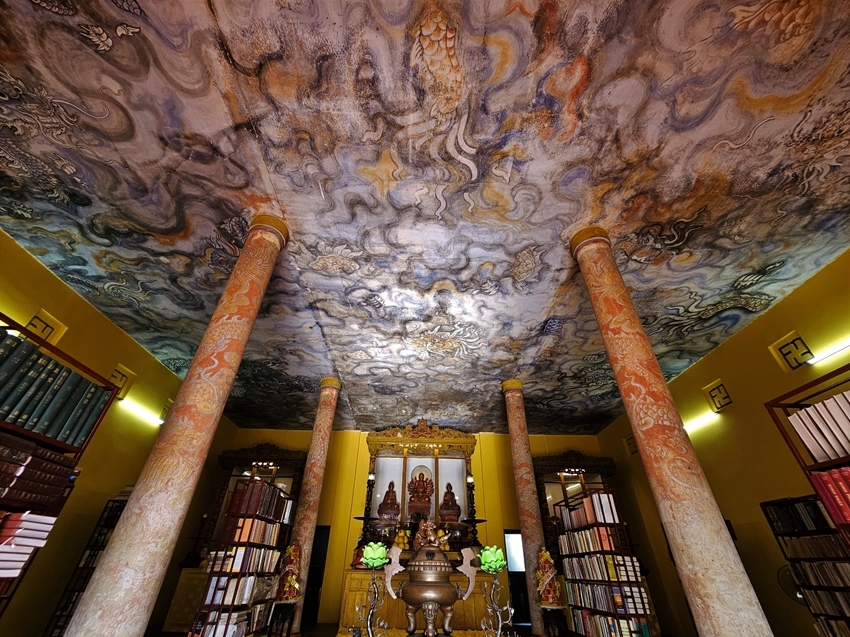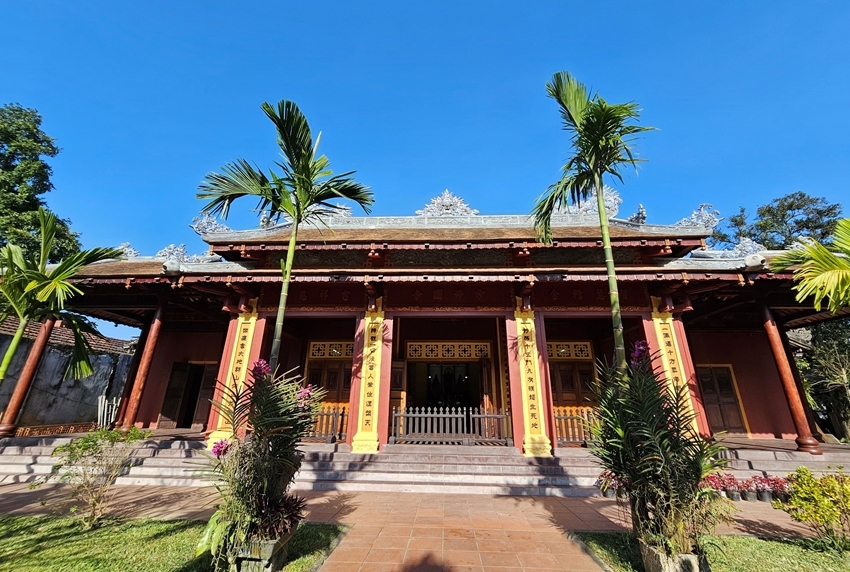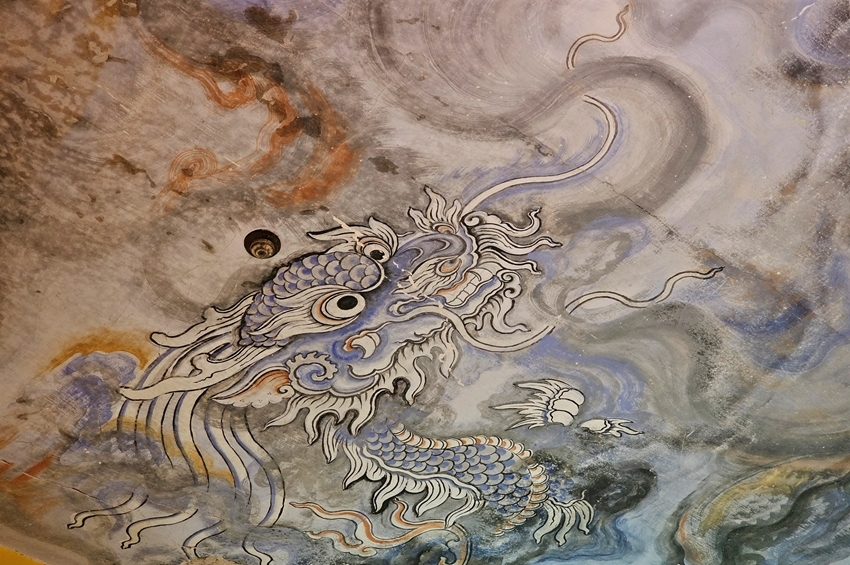 |
| The painting "Long van khe hoi" on the ceiling of Dieu De Pagoda's main hall |
Moving the main hall to preserve the dragon painting
The pagoda decided to keep this work by hiring the genie Nguyen Van Cu from Ho Chi Minh City to move the main hall, so that today the beautifully painted dragon is still intact. During the Lunar New Year of 2024 - we returned to the ancient pagoda located at 110 Bach Dang Street, facing the Dong Ba River, to admire the artwork classified as extremely rare.
The old main hall of Dieu De Pagoda was moved back nearly 20 meters from its original position by the genie Nguyen Van Cu and his team, with the support of modern machinery, at the end of 2022. This decision was considered quite bold by the pagoda after much deliberation and calculation. After more than a month, the main hall, weighing over a thousand tons, was successfully moved. At that time, besides ensuring safety, it was imperative to preserve the integrity of the painting at all costs.
 |
| The old main hall of Dieu De Pagoda after being moved back has been renovated and reinforced |
After being moved to its new position, the main hall has been elegantly renovated. In addition to preserving the altars, now inside this space there are bookshelves serving the study needs of the monks.
Looking up from below, the artwork "Long van khe hoi" remains intact and shimmering, as if there had been no previous changes or movements. The painting, with a length of over 10 meters and a width of nearly 11 meters, almost covers the entire ceiling of the main hall, depicting 5 dragons winding through layers of clouds on the ceiling and 4 dragons wrapping around 4 large columns according to an ancient Buddhist tale.
Many visitors to Dieu De Pagoda could not help but marvel at the fact that the pagoda still retains the old main hall, and more importantly, preserves this rare masterpiece of art. "The dragons painted on the ceiling of Dieu De Pagoda's old main hall are so beautiful, so exquisite. Despite the tribulations of history, the deliberation in the restoration process, the pagoda still manages to keep it, which is truly remarkable," said Nguyen Duy Vu (from Hue City) in admiration.
Hoping for the best preservation
According to our research, this main hall was rebuilt by Most Venerable Dieu Hoang with contributions from Empress Dowager Tu Cung (the mother of Emperor Bao Dai), and the work was carried out from 1953 to 1955.
The inauguration ceremony was held in 1955. And the painting "Long van khe hoi" was painted during the period from 1953-1955, not during the reign of Emperor Khai Dinh as some information has claimed. The ceiling of the main hall was not cast in sturdy reinforced concrete but was made using a mesh of steel with plaster, of rather low quality. Although the temple contacted some people who had lived in Dieu De Pagoda from 1951 onwards to inquire, the information about the painter still remains unclear.
Previously, since its construction by Emperor Thieu Tri in 1844, Dieu De Pagoda had a wooden structure in the characteristic royal architectural style of the Nguyen dynasty, which developed from the traditional architectural style of Hue's ruong houses. The construction underwent several renovations, although it was not as grand as the initial scale, it still maintained the old architectural style until 1951.
 |
| One of the dragons on the main hall's ceiling is extremely impressive |
Today, Dieu De Pagoda is a prominent landmark in Hue, a region known as the land of Buddhism. Every year, the Buddha Bathing Ceremony, the Buddha Procession of Hue Buddhism, is held at the pagoda during Vesak. The special feature here is that this pagoda embodies many characteristics of the royal court, closely associated with Emperor Thieu Tri, the third emperor of the Nguyen dynasty. From its establishment until 1945, Dieu De Pagoda was classified as a National Pagoda (along with Giac Hoang, Thien Mu, and Thanh Duyen Pagodas) by the Nguyen dynasty.
Venerable Thich Hai Duc, the abbot of Dieu De Pagoda, said that after the old main hall was moved back, the pagoda reinforced the surrounding walls, leaving almost no impact on the "Long van khe hoi" painting on the ceiling. Now this main hall has become the ancestral house for worshiping Buddha and the emperors...
"We are trying to preserve the artwork, but the preservation of the pagoda is almost beyond our capacity to intervene," Venerable Thich Hai Duc shared, adding that when the hall was moved back, it was raised higher than before, making the space quite spacious. Venerable Thich Hai Duc also hopes that in the future, experts or those with similar aspirations will find ways to preserve this unique and rare dragon painting located in the famous ancient pagoda of the land of the ancient capital.
